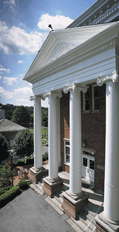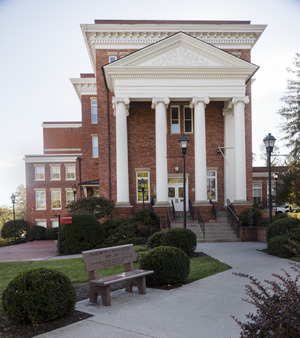Carnegie Hall, Inc. facts for kids
Carnegie Hall, Inc. is a special place for arts and culture in Lewisburg, West Virginia, USA. It's nestled in the beautiful Allegheny Mountains. This center helps people in Monroe, Greenbrier, Pocahontas, and Summers Counties enjoy the arts. This area covers about 2,900 square miles and has around 73,000 people.
Every year, Carnegie Hall, Inc. welcomes over 75,000 visitors. They offer live shows by artists from all over the world. They also have art classes, workshops, and art exhibits. Carnegie Hall, Inc. is one of only eight Carnegie Halls still used for performances today.
Contents
What Carnegie Hall Does
Carnegie Hall, Inc.'s main saying is "Bringing the Arts to Life!" In 2017, they shared their goal: Carnegie Hall wants to help everyone love creativity and great art. They work with the community to offer many different programs. These programs entertain, teach, and involve people of all ages. They also work to keep the historic building safe and important.
Carnegie Hall's Story
The building we know as Carnegie Hall started as the Lewisburg Academy around 1812. It was a school for both boys and girls. Later, in the 1870s, the academy split into two schools. These were the Greenbrier Military School and the Lewisburg Female Institute (LFI).
The Lewisburg Female Institute was a boarding school just for girls. Girls could attend from first grade all the way to twelfth grade. In 1937, the school changed its focus. Girls could then attend for four years, which included two years of high school and two years of college. The arts were always very important at LFI. Many students took music classes in the early 1900s. Girls could study many subjects, like math, English, history, and science.
On December 16, 1901, a fire destroyed the original LFI buildings. Classes were held in other places, like City Hall, for the rest of that school year.
Building the New Hall
To get money for a new building, the school's president, Dr. R. L. Telford, wrote to James Bertram. He was the private secretary for Andrew Carnegie. Andrew Carnegie was famous for giving money to good causes. He first gave $20,000 for the new building. Then he gave another $6,750 to finish the auditorium. Carnegie asked the local community to raise $10,000. The total cost of building would be over $1 million in today's money.
The Lewisburg Female Institute used Carnegie Hall as classroom space until 1972. The building had a science lab, music practice rooms, and an auditorium. In the 1940s and 1950s, Carnegie Hall hosted free concerts. These concerts were for students and the community. They featured many different musicians.
In 1971-1972, Greenbrier College (which LFI became) allowed men to attend for one year. Only four male students lived on campus. Co-ed classes were only for high school students.
Saving Carnegie Hall
Due to low student numbers and money problems, Greenbrier College closed in May 1972. After the college closed, Carnegie Hall became part of the Greenbrier Center. This center helped people with special needs. In the early 1980s, people in Lewisburg worried the building might be torn down.
Because the building was so important, several Lewisburg residents started Carnegie Hall, Inc. in 1983. At first, they offered free shows in the historic building. This helped bring back interest in arts and history. The first official performance season began in 1990.
On Christmas Eve 1996, a fire damaged the building again. Carnegie Hall, Inc. started a huge project to fix it. This renovation took almost a year to complete.
Building Design and Updates
The original Carnegie Hall building was designed in 1902. It was built in the Georgian Revival style. This style often has a grand front porch with columns and a triangular roof. It also features tall windows on the first floor. The rest of the building is made of simple, rectangular parts with flat roofs.
A big renovation was finished on June 18, 1997. This project added an elevator, offices, and an easier entrance. These changes made the building more accessible for everyone.
In 2006, the front entrance was updated again. This was to follow rules that help people with disabilities. These updates included a ramp and leveled floors.
Famous Performances
Today, artists from all over the world perform in Carnegie Hall's Hamilton Auditorium. Some famous performers have included:
- Mose Allison
- Asleep at the Wheel
- Mary Chapin Carpenter
- Arlo Guthrie
- Richie Havens
- Ladysmith Black Mambo
- Taj Mahal
- Wynton Marsalis
- Kathy Mattea
- Josh Ritter
- Ricky Skaggs
- Isaac Stern
- The Seldom Scene
- Vienna Boys' Choir
- Doc Watson
- Gillian Welch
- Chatham County Line
Carnegie Hall Today
Carnegie Hall, Inc. is a non-profit organization. It offers arts education and programs for young people and adults all year. Besides their main concert series, they have many educational art programs.
Carnegie Hall hosts two fundraising events each year. One is "Taste of Our Towns" (TOOT), a street food festival. It happens every year on the second Saturday in October. The other is the Carnegie Hall Gala. Since 2017, this event has been held at The Greenbrier in White Sulphur Springs.
Carnegie Hall has three art galleries. It is also the permanent home of the West Virginia Music Hall of Fame. Visitors can explore the building on their own or take a guided tour.
Other Buildings Named Carnegie Hall
There are seven other Carnegie Halls around the world that are still used for performances. These include:
- Carnegie Hall in Dunfermline, Scotland. This is Andrew Carnegie's hometown.
- Carnegie Music Hall in Pittsburgh, Pennsylvania. This is the second biggest Carnegie Hall. It's part of the Carnegie Museums of Pittsburgh.
- Carnegie Hall on the North Side of Pittsburgh. This was the first Carnegie Music Hall to open in the USA.
- Carnegie Music Hall in Braddock, Pennsylvania. It's part of the Carnegie library there.
- Carnegie Music Hall in Homestead, Pennsylvania. This building also has a library, gym, and swimming pool.
- Carnegie Music Hall in Carnegie, Pennsylvania. It's attached to the Carnegie library.
- Andrew Carnegie also built a Library and Music Hall in Duquesne, Pennsylvania. This building was taken down in 1968.
- The most famous Carnegie Hall is in New York City.
See also
- List of concert halls



